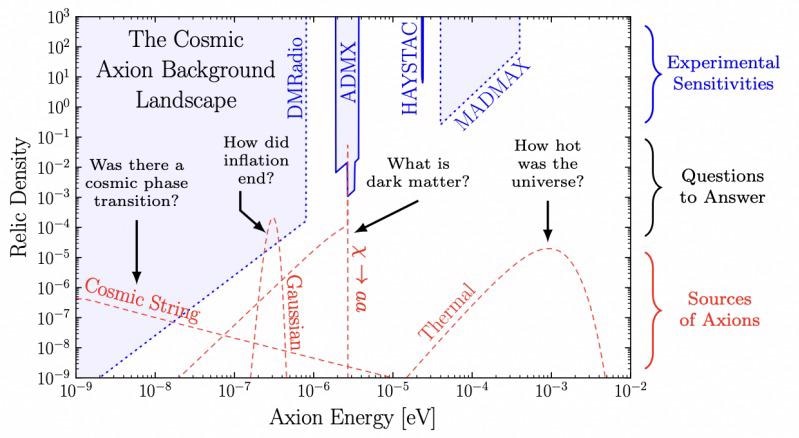Jun 8 2021
According to a new study published in the Physical Review D journal on June 7th, 2021, identifying the hypothetical particle axion could mean identifying for the first time what exactly occurred in the Universe a second after the Big Bang.
 The variation in the form of the CaB as a function of energy and density can be seen for four different scenarios for its production. Finding any one of these would help answer the fundamental questions listed. Image Credit: Dror et al.
The variation in the form of the CaB as a function of energy and density can be seen for four different scenarios for its production. Finding any one of these would help answer the fundamental questions listed. Image Credit: Dror et al.
But the question is how far back can we look into the Universe’s past today? Within the electromagnetic spectrum, visualizations of the Cosmic Microwave Background, often called the CMB, enable humans to look back nearly 14 billion years to when the Universe cooled adequately enough for electrons and protons to merge and develop neutral hydrogen.
The CMB has taught us an inordinate amount about the emergence of the cosmos. However, photons in the CMB were discharged 400,000 years following the Big Bang, thus rendering it very difficult to find out the history of the universe before this period.
To make a breakthrough, a trio of theoretical researchers, including Kavli Institute for the Physics and Mathematics of the Universe (Kavli IPMU) Principal Investigator, University of California, Berkeley, MacAdams Professor of Physics, and Lawrence Berkeley National Laboratory senior faculty scientist Hitoshi Murayama, Lawrence Berkeley National Laboratory physics researcher and the University of California, Berkeley, postdoctoral fellow Jeff Dror (currently working at University of California, Santa Cruz) and UC Berkeley Miller Research Fellow Nicholas Rodd, looked further than photons and into the world of hypothetical particles called axions, which could have been discharged in the first second of the history of the Universe.
In their article, the researchers proposed the viability of looking for an axion analog of the CMB, a supposed Cosmic axion Background (CaB). Although hypothetical, there are several reasons to believe that the axion could be present in the Universe.
For one, axions are essentially a generic forecast of string theory, one of the current best hopes for quantum gravity theory. Additionally, the presence of an axion could help resolve the historical mystery of why humans are yet to quantify an electric dipole moment for the neutron, a problem that is more officially referred to as the “Strong CP Problem.”
Recently, the axion has become a potential candidate for dark matter, and as a result, researchers are quickly searching for axion dark matter.
In their article, the team pointed out that as experimentalists devise more sensitive instrumentation to look for dark matter, they are likely to encounter another sign of axions in the form of the CaB. However, since the CaB shares almost the same properties as those of the dark-matter axions, the experiments are likely to throw the CaB signal out as noise.
Determining the CaB at one of these instruments would be a double breakthrough. Not only would it verify the presence of the axion, but researchers from all over the world would instantly have a new fossil from the early Universe. Based on how the CaB was generated, researchers could learn several different features of the Universe's evolution that was not possible before.
What we have proposed is that, by changing the way current experiments analyze data, we may be able to search for left-over axions from the early universe. Then, we might be able to learn about the origin of dark matter, phase transition or inflation at the beginning of the Universe. There are already experimental groups who have shown interest in our proposal, and I hope we can find out something new about the early Universe that wasn’t known before.
Hitoshi Murayama, MacAdams Professor of Physics and Lawrence Berkeley National Laboratory Senior Faculty Scientist, Kavli Institute for the Physics and Mathematics of the Universe
“The evolution of the universe can produce axions with a characteristic energy distribution. By detecting the energy density of the universe currently made up of axions, experiments such as MADMAX, HAYSTAC, ADMX, and DMRadio could give us answers to some of the most important puzzles in cosmology, such as, ‘How hot did our universe get?’, 'What is nature of dark matter?’, ‘Did our universe undergo a period of rapid expansion known as inflation?’, and ‘Was there ever a cosmic phase transition?’,” stated Dror.
This latest study offers a reason to be fascinated about the axion dark-matter program. But even if the dark matter is not composed of axions, such instruments may give a picture of the Universe when it was less than a second old.
Journal Reference:
Dror, J. A., et al. (2021) Cosmic axion background. Physical Review D. doi.org/10.1103/PhysRevD.103.115004.